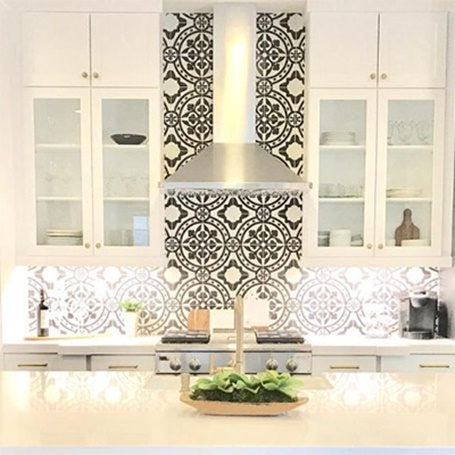
Choosing the Perfect Backsplash Tile Layout: Horizontal, Vertical, or Chevron?
February 14, 2024
When it comes to kitchen renovations, selecting the right tile pattern can dramatically alter the look and feel of your space. The backsplash not only protects the walls from spills and splatters but also serves as a focal point of your kitchen décor. The choice between horizontal, vertical, or chevron tile layouts can be daunting, but each offers its unique aesthetic and stylistic flair to your home. This guide will walk you through the options, helping you make an informed decision that reflects your personal style and complements your kitchen’s design.
The backsplash is one area of your kitchen where you can be creative, and the layout you choose can make a significant impact. Whether you opt for a traditional horizontal layout, a modern vertical pattern, or a dynamic chevron design, the alignment of your backsplash tile can transform the perception of space and set the tone for your kitchen. The right layout will enhance your kitchen’s design, making it appear more spacious, vibrant, and tailored to your taste.
Horizontal Hold: The Classic Backsplash Choice
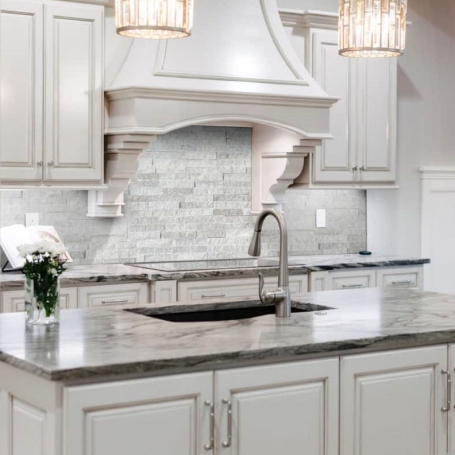
Why Horizontal Tiles Reign Supreme in Kitchen Design
The horizontal tile layout is a timeless choice that embodies a classic aesthetic. It’s no wonder that it continues to be a favorite in many homes. The long lines of a horizontal backsplash tile create a visually widening effect, making your kitchen space appear larger and more open. This is particularly beneficial for smaller kitchens where space is at a premium.
Moreover, the horizontal orientation is versatile and can support a variety of tile sizes and styles. From sleek subway tiles to rustic hand-painted options, horizontal backsplash tiles accommodate a broad spectrum of design preferences. They also lend themselves well to color variation, allowing for subtle or bold contrasts that can enhance the overall kitchen palette.
Maximizing Your Space with Horizontal Tiles
Not only does the horizontal layout offer a traditional and welcoming look, but it also has practical advantages. For one, it tends to catch the light more effectively, which can brighten up your cooking area. Additionally, horizontal tiles are generally easier to clean due to their alignment with kitchen countertops and cabinets, which provides a smooth transition from one surface to another.
In terms of installation, horizontal tiles can be more forgiving, especially for DIY enthusiasts. They require less cutting and fitting around cabinets and appliances, making the installation process more straightforward and less time-consuming.
Here are examples of the type of tiles that are conducive to this popular layout:
- Subway Tiles: The quintessential choice for horizontal layouts, subway tiles offer a classic, clean look that can work with just about any design aesthetic. Their rectangular shape naturally complements a horizontal layout, creating a widening effect on the space.
- Glass Tiles: For a modern twist, glass tiles in a horizontal layout reflect light beautifully, contributing to a bright and open feel. Their transparency and gloss can make a space feel more airy and less confined.
- Ceramic and Porcelain Tiles: Durable and easy to clean, ceramic and porcelain tiles are perfect for a traditional horizontal layout. They come in a variety of colors and patterns, allowing for versatility in design without compromising functionality.
Vertical Verve: A Trendy Twist on Tile Layouts
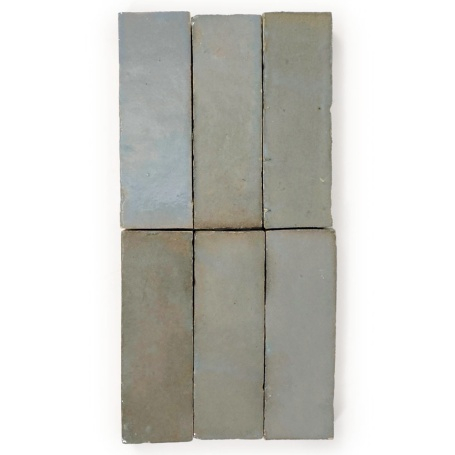
The Rise of Vertical Tile Layouts in Modern Kitchens
Vertical tile layouts are quickly becoming a popular trend for those looking to add a contemporary edge to their kitchen. When backsplash tiles are positioned vertically, they can give the illusion of higher ceilings, drawing the eye upward and creating a sense of grandeur and space. This is an excellent tactic for rooms with lower ceilings or compact areas where you want to create the feeling of additional volume.
The vertical arrangement also allows for creative expression through the use of different tile lengths and colors, which can create striking patterns that stand out as artful focal points. For a more subtle approach, monochromatic and textured tiles can offer depth and interest without overwhelming the space.
Benefits of Choosing Vertical Backsplash Tiles
Aside from their aesthetic appeal, vertical tiles can offer functional benefits. They can be particularly effective in protecting walls from water damage due to less horizontal ledge space where water could potentially pool. Additionally, vertical patterns can be less common and therefore give your kitchen a unique, custom look that sets it apart from the conventional.
The installation of vertical tiles can be slightly more challenging than horizontal tiles due to the need for precise alignment. However, the end result can be incredibly rewarding, providing a stunning backdrop that becomes a conversation piece in its own right.
Consider these types of tiles for a vertical tile to add height and modernity in your space:
- Long, Skinny Tiles: Sometimes referred to as “finger tiles,” these can create a waterfall effect, emphasizing verticality and making ceilings appear higher. They are especially conducive to a vertical pattern due to their elongated shape.
- Mosaic Tiles: While commonly used in smaller, square shapes for intricate patterns, mosaic tiles can also be arranged in vertical stripes. This can add a level of detail and sophistication to a backsplash or shower wall.
- Wood-Look Tiles: With the trend towards natural and rustic aesthetics, wood-look tiles in porcelain can add warmth and texture in a vertical layout. They can provide the illusion of wooden planks aligned vertically, which is not a common sight and can act as a statement design element.
Chic Chevron: The Bold and Dynamic Layout Option
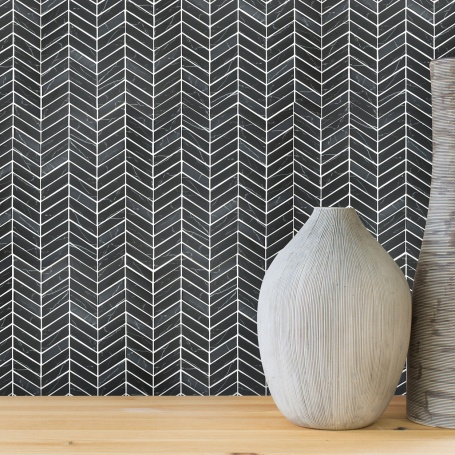
Why Chevron Backsplash Tiles Make a Statement
The chevron pattern, with its distinctive ‘V’ shape, is for those who dare to be different. A chevron backsplash tile layout is dynamic and can add instant movement and energy to your kitchen. It’s an adventurous choice that reflects a bold personality and a penchant for design risks that pay off visually.
Chevron patterns can vary in size and color, allowing for a customized look that can be tailored to suit any style, from minimalist to eclectic. They are particularly effective in drawing attention to the backsplash as a standout feature in your kitchen.
Perfecting Your Kitchen with a Chevron Pattern
Incorporating a chevron tile layout can add a layer of sophistication to your space. The pattern can create focal points and highlight specific areas of your kitchen, such as the cooktop or the sink. Chevron tiles often require more cuts and detailed planning, but the end result is a mesmerizing pattern that can elevate the design of your kitchen to the next level.
Although chevron tiles can be more costly and complex to install, they can increase the value of your home by contributing a high-end, designer feel to your kitchen. The investment in a chevron backsplash could pay off in both aesthetic enjoyment and market appeal.
These types of tiles work really well in a chevron pattern:
- Cut Natural Stone Tiles: Natural stone like marble or slate can be cut into parallelograms or trapezoids and laid in a chevron pattern. This not only creates a striking visual impact but also brings the luxury of natural stone into the design.
- Chevron Pattern Tiles: Some manufacturers offer tiles already shaped for chevron patterns. These are ideal for creating this dynamic look without the need for complex cuts, ensuring a consistent and seamless pattern.
- Encaustic Cement Tiles: Known for their vibrant patterns and colors, encaustic cement tiles can be used to create a chevron pattern that’s both tactile and visually arresting. They add an artisanal, handcrafted feel to a space.
Making Your Decision: Factors to Consider for Your Backsplash Tile Layout
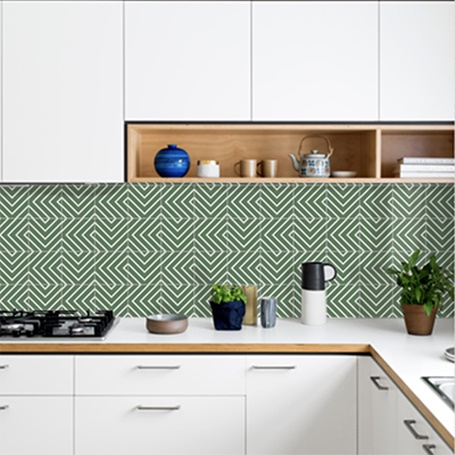
When choosing between horizontal, vertical, or chevron layouts for your backsplash tile, there are several factors to consider:
- Room size and ceiling height: Horizontal tiles can make a room feel wider, while vertical tiles can make ceilings appear higher.
- Personal style: Your backsplash is an expression of your taste. Choose a pattern that reflects your personality and complements your home’s décor.
- Maintenance: Consider how much time you’re willing to spend on cleaning and maintenance, as some layouts may require more upkeep than others.
- Budget: Your budget may dictate your options. Chevron patterns can be more expensive due to the complexity of the design.
- Taking these factors into account will help you make a backsplash tile decision that you’ll be happy with for years to come.
FAQs on Backsplash Tile Layouts
1. Can backsplash tiles really make my kitchen look bigger?
Absolutely! The layout of your backsplash tile can greatly affect the perception of space within your kitchen. A horizontal tile layout tends to make the space appear wider, especially if you use lighter colors that reflect more light. Conversely, a vertical layout can draw the eye upward, making the ceiling seem higher and the room larger.
The optical illusion created by backsplash tiles is not just a matter of layout but also of color and shine. Glossy tiles reflect light, enhancing the spaciousness of the area. Additionally, the continuous pattern of tiles without interruption can create a seamless look that contributes to a feeling of extended space.
2. How do I choose the right backsplash tile layout for my home?
Choosing the right backsplash tile layout depends on several factors, including your kitchen’s size, your home’s overall style, and your personal preferences. If you have a small kitchen and want to make it appear larger, horizontal tiles might be the best choice. For adding height or a modern touch, consider vertical tiles. If you’re looking to make a bold statement, the chevron layout might be your go-to.
Consider the maintenance and the installation process as well. Horizontal tiles are generally easier to install and maintain, while chevron tiles may require professional installation due to their complex patterns. Ultimately, the best layout for your home is one that meets your aesthetic, practical, and budgetary needs.
3. What are the current trends in backsplash tile layouts?
The current trends in backsplash tile layouts favor personalization and unique design. Vertical and chevron layouts are on the rise, offering a fresh take on the traditional horizontal pattern. These layouts are especially popular in modern and contemporary kitchens.
Textured tiles and those with geometric patterns are also trending, providing depth and character to kitchen spaces. Homeowners are increasingly opting for handcrafted tiles that add a touch of artisanal quality to their backsplash designs.
4. Are there any innovative materials for backsplash tiles?
Yes, the market is full of innovative materials for backsplash tiles. Beyond the traditional ceramic and porcelain, homeowners can now choose from glass, metal, stone, and even eco-friendly recycled materials. Each material offers its own unique texture, color options, and maintenance requirements.
For those looking for sustainable options, tiles made from recycled glass or reclaimed materials are gaining popularity. Not only do they provide an environmentally friendly choice, but they also offer a unique look that can add to the overall design of your kitchen.
5. How do I maintain my backsplash tile to keep it looking new?
Maintaining your backsplash tile involves regular cleaning and, in some cases, sealing. For most tiles, wiping with a damp cloth or sponge with mild soap is enough to remove everyday grime and spills. For grout lines, a small brush and a mixture of water and baking soda can help maintain cleanliness.
If you have natural stone tiles, they may require sealing periodically to prevent staining and water damage. Always follow the manufacturer’s recommendations for cleaning and maintenance to ensure your backsplash remains in pristine condition.